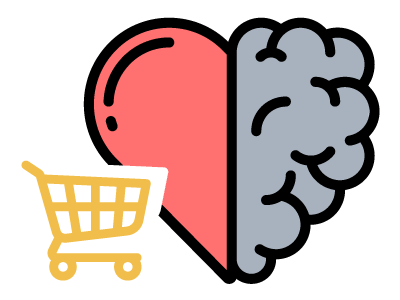We live in a world of online shoppers. This is due to people staying at home more often which has turned the population into a huge influx of digital buyers. For this reason, the rates of people online shopping have greatly increased. This has created mixed effects on online shopping and mental health.
Did you know that while in 2020, over two billion customers purchased products and services online this number is expected to grow to to five and a half billion by 2027.
For customers, recent research shows that online shopping can reduce sadness and restore a sense of control. If done in moderation, retail therapy – such as browsing clothes or working-from-home electronics – is considered to give customers psychological and therapeutic value.
Here are some examples of how online shopping can provide therapeutic value for customers:
- Happiness hits customers before a purchase is even made. The anticipation and possibility of buying a product releases dopamine, a chemical in the brain which is the feel-good hormone.
- Visualization distracts customers from anxiety. Shoppers feel positive with less pressure. If they can see merchandised and custom items. Customers can also imagine themselves in the brand’s setting. For ecommerce retailers, visually seeing how clothes could look on the customer using digital technology, is important for a great customer experience.
- Online shopping can make you have a happier mood. The post-purchase customer experience can also fuel dopamine release. For example, ecommerce retailers such as subscription box retailers, increase the level of excitement and anticipation as the customers do not know the content of each box.
- Get psychological perks of saving up for a product that you really want. Customers can get excited to save up tokens or points to buy something that they really want. Ecommerce retailers can create loyalty rewards programs to boost online sales.
Despite all these benefits, though, online shopping can become a problem if not managed well.
Buying things online with the click of a button is tempting for shoppers to spend beyond their means. Mental health issues may appear, such as ‘compulsive buying disorder’. Although only 6% of the US population has compulsive buying disorder, tools such as ‘Buy Now’ buttons, click-and-collect, one-click ordering, and saving credit card details into profiles make online impulse purchases easier. Because it’s so easy and accessible, shopping can become addictive.
Customers could consider revisiting and changing their shopping habits.
Here are some tips for people to avoid making impulse purchases and reduce overspending shopping habits:
- Shop with a plan in mind: List what is needed before completing any purchases. Only buy what is on the list and resist the temptation to buy unnecessary items
- Research before purchasing: Research items that you need, and read reviews to ensure they are worth the purchase
- Set a reasonable budget: Set aside an amount that covers your necessary expenses
- Implement a waitlist for large purchases: Write down all expensive items and only purchase them after 30 day
- Pay attention to why customers are buying: Are there problems at work, home or school that are influencing shopping habits?
Final Thoughts
Online shopping is set to remain a significant part of life for both consumers and e-commerce retailers. While online shopping behaviors display both healthy and unhealthy traits, understanding their impact on mental health is crucial for maximizing the benefits of the online purchase experience.
If used well, retail therapy can release dopamine and give us feelings of motivation and happiness. If abused, compulsive shopping and overspending will continue to be a problem for the customer. Recovering from shopping addiction is possible as there are ways to avoid overspending.
Retail therapy, when used appropriately, can release dopamine, fostering feelings of motivation and happiness. However, compulsive shopping and overspending remain potential risks for consumers. Fortunately, recovering from shopping addiction is possible, and there are strategies to avoid overspending.

E-commerce retailers can play a pivotal role in promoting positive shopping behaviors. By leveraging technology, retailers can contribute to better mental health outcomes for their customers. Here’s how:
- Engage and Educate: Retailers can use post-purchase communications to educate customers about responsible spending habits and the psychological impacts of shopping.
- Reward Mindful Shopping: Implement loyalty programs that reward customers not just for frequent purchases but for mindful shopping behaviors.
- Monitor Shopping Patterns: Utilize data to identify and reach out to customers who might be exhibiting signs of compulsive buying, offering support or resources.
- Enhance the Anticipation Experience: Since anticipation can be a source of joy, retailers can use shipment and order progress notifications to enhance this aspect, making the wait part of the therapeutic experience.
- Personalized Support: Offer personalized post-purchase support, acknowledging individual customer preferences and needs, which can contribute to a more satisfying and less impulsive shopping experience.
By adopting these strategies, retailers can not only foster a healthier shopping environment but also build a stronger, more empathetic relationship with their customers. In doing so, the shopping experience becomes positive and rewarding for everyone involved, contributing to overall mental well-being and sustainable consumer habits.



